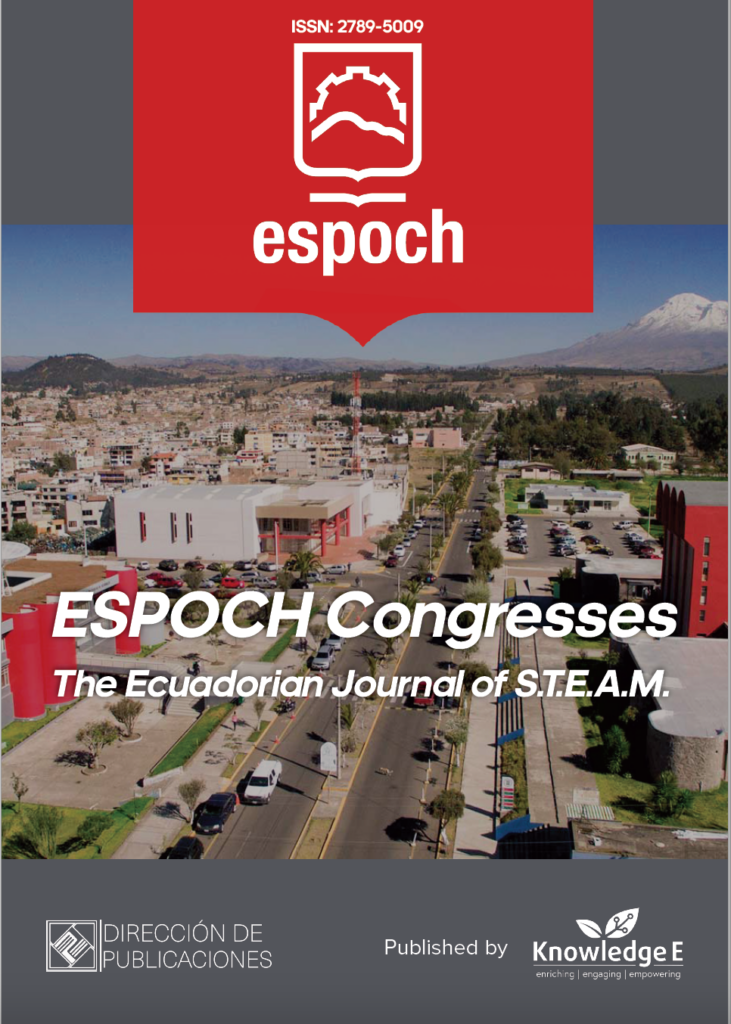
ESPOCH Congresses: The Ecuadorian Journal of S.T.E.A.M.
ISSN: 2789-5009
Leading Ecuadorian research in science, technology, engineering, arts, and mathematics.
Ewing's Sarcoma: A Case Report
Published date:Sep 09 2021
Journal Title: ESPOCH Congresses: The Ecuadorian Journal of S.T.E.A.M.
Issue title: Volume 1, Issue 6
Pages:1723 - 1733
Authors:
Abstract:
Ewing’s sarcoma is a bone tumor, considered one of the most aggressive, for its great capacity of metastasizing. Higher incidence in men, appears almost exclusively in the first three decades of life. Affects the long bones in the metaphyseal region, at its proximal end; the most affected are the femur, iliac, tibia, humerus, fibula and ribs; however, there are atypical locations such as in the hands, feet and extraosseous. The clinical case of a 13‐year‐old male adolescent patient, who two months before his medical attention presented a mass at the level of the second and third right costal arches that increased vertiginously. After routine and laboratory examinations performed at a third level complexity hospital, he was diagnosed with Ewing's Sarcoma, where 3 chemotherapy sessions were performed; however, despite the treatment, he presented brain and bone metastases. Ewing's tumor was highly aggressive and has a bleak prognosis.
Keywords: sarcoma, ewing, tomography, morbid metastasis.
RESUMEN
El Sarcoma de Ewing es un tumor óseo, considerado uno de los más agresivos, por su gran capacidad de metástasis. Tiene mayor incidencia en hombres, se presentan de forma casi exclusiva en las tres primeras décadas de vida, afecta a los huesos largos en la región metafisodiafisaria, en su extremo proximal, los más afectados son el fémur, el iliaco, la tibia, el humero, el peroné y las costillas. Sin embargo, existen localizaciones atípicas como en los pies manos y extraóseas. Se presentación el caso de un paciente adolescente masculino de 13 años, que dos meses antes de la atención médica presenta una masa a nivel de segundo y tercer arco costal derecho que aumenta de tamaño de forma vertiginosa. Posterior a exámenes de gabinete y laboratorio realizados en Hospital de Tercer Nivel de Complejidad, es diagnosticado de Sarcoma de Ewing en donde se realizan 3 sesiones de quimioterapia, sin embargo, pese el tratamiento presenta metástasis cerebrales y óseas, El tumor de Ewing es altamente agresivo y tiene un pronóstico sombrío
Palabras claves: sarcoma de ewing, tomografía, metástasis mórbida.
References:
[1]Resnick D, Kyriakos M. Tumors and tumor‐like lesions of bone: Imaging and pathology of specific lesions. Philadelphia: Saunders; 2002. 4060–4065 p.
[2]Fuentes E, Tornes K, Fuentes J. Sarcoma de ewing nasosinusal en la infancia. Multimed rRevista Médica Granma. 2020;24(1):190–9.
[3]Baruchel S, Pappo A, Krailo M, et al. A phase 2 trial of trabectedin in children with recurrent rhabdomyosarcoma, Ewing sarcoma and non‐rhabdomyosarcoma soft tissue sarcomas: A report from the Children’s Oncology Group. Eur J Cancer. 2012;48(4):579–85.
[4]Collier AB, Simpson L, Monteleone P. Cutaneous Ewing sarcoma: Report of 2 cases and literature review of presentation, treatment, and outcome of 76 other reported cases. J Pediatr Hematol Oncol. 2011;33(8):631–4.
[5]Antelo JS, García CR, Martínez CM, Hernando HV. Sarcoma de Ewing pulmonar/tumor neuroectodérmico primitivo (PNET): aportación de un caso y revisión de la bibliografía. Arch Bronconeumol. 2010;46(1):44–6.
[6]Tirode F. Biology of Ewing sarcoma. Bone cancer prim bone cancers bone metastases. 2nd ed. 2015;2013:245–55.
[7]Grünewald TGP, Cidre‐Aranaz F, Surdez D, et al. Ewing sarcoma. Nat Rev Dis Prim. 2018;4(1).
[8]Crompton BD, Stewart C, Taylor‐Weiner A, et al. The genomic landscape of pediatric Ewing sarcoma. Cancer Discov. 2014;4(11):1326–41.
[9]Ladenstein R, Pötschger U, Le Deley MC, et al. Primary disseminated multifocal Ewing sarcoma: Results of the Euro‐EWING 99 trial. J Clin Oncol. 2010;28(20):3284–91.
[10] Jiménez E, Chinchilla L, Gómez A, Avilés A, Martínez A. Sarcoma de mediastino. Rev la Fac la UNAM. 2017;60(3):6–17.
[11] Dini LI, Mendonça R, Gallo P. Primary Ewing’s sarcoma of the spine: Case report. Arq Neuropsiquiatr. 2006;64(3 A):654–9.
[12] Machado I, Cruz J, Lavernia J, et al. Superficial EWSR1‐negative undifferentiated small round cell sarcoma with CIC/DUX4 gene fusion: A new variant of Ewing-like tumors with locoregional lymph node metastasis. Virchows Arch. 2013;463(6):837–42.
[13] Bendahan V, Tejada J, Gómez C, et al. Localizaciones atípicas del Sarcoma de Ewing: A propósito de dos casos Objetivo docente. Seram. 2012;1–17.
[14] Millán E, Corona R, Ríos N. Sarcoma de Ewing en paciente masculino Ewing’s sarcoma in a male patient. Rev Cuba Med Gen Integr. 2010;26(3):569–75.
[15] Vivas‐Flores CI, Pantoja‐Garrido M, Frías‐Sánchez Z. Extraosseous Ewing’s sarcoma of gynaecological origin: Primitive neuroectodermal tumour of infrequent location. Case report and review of the literature. Rev Colomb Obstet Ginecol. 2017;68(2):135–41.
[16] Esiashvili N, Goodman M, Marcus RB. changes in incidence and survival of ewing sarcoma patients over the past 3 decades. J Pediatr Hematol Oncol. 2008;30(6):425–30.
[17] Hauben E, Van de Broek L, Van Marck E, Hogendoorn P. Adamantinoma‐like Ewing’s sarcoma and Ewing’s‐like. J Pathol. 2001;195:218–21.
[18] Hisaoka M, Matsuyama A, Nagao Y, et al. Identification of Altered MicroRNA Expression Patterns in Synovial Sarcoma. Cancer. 2011;396(January):389–96.
[19] Catalan J, Fonte AC da, Lusa JRB, Oliveira AD de, Melo ES de, Gonçalves CM. Sarcoma de Ewing: Aspectos clínicos e radiográficos de 226 casos. Radiol Bras. 2005;38(5):333–6.
[20] Cotterill SJ, Ahrens S, Paulussen M, et al. Prognostic factors in Ewing’s tumor of bone: Analysis of 975 patients from the European Intergroup Cooperative Ewing’s Sarcoma Study Group. J Clin Oncol. 2000;18(17):3108–14.
[21] Murphey MD, Senchak LT, Mambalam PK, Logie CI, Klassen‐Fischer MK, Kransdorf MJ. From the radiologic pathology archives: Ewing sarcoma family of tumors: Radiologic‐pathologic correlation. Radiographics. 2013;33(3):803–31.
[22] Batsakis JG, El‐Naggar AK. Ewingʼs sarcoma and primitive neuroectodermal tumors. Adv Anat Pathol. 1997;4(4):207–20.
[23] Souvirón Encabo R, Arenas Britez O, Gil R, Pérez‐Luengo E, Scola Yurrita B. Tumor neuroectodérmico primitivo periférico/Sarcoma de Ewing Extraóseo del hueso temporal. Acta Otorrinolaringol Esp. 2005;56(1):38– 40.
[24] Riggi N, Stamenkovic I. The Biology of Ewing sarcoma. Cancer Lett. 2007;254(1):1–10.
[25] Kumagai A, Motoi T, Tsuji K, Imamura T, Fukusato T. Detection of SYT and EWS gene rearrangements by dual‐ color break‐apart CISH in liquid‐based cytology samples of synovial sarcoma and Ewing sarcoma/primitive neuroectodermal tumor. Am J Clin Pathol. 2010;134(2):323–31.